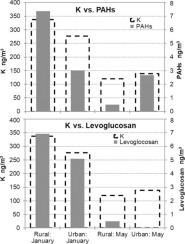Particuology ( IF 4.1 ) Pub Date : 2019-06-29 , DOI: 10.1016/j.partic.2019.05.001 Orhan Sevimoğlu , Wolfgang F. Rogge

|
The largest sugarcane-growing area in the United States is in South Florida. An estimated 7 million tons of dry sugarcane leafy biomass is removed from the fields before harvest by burning the leaves off the sugarcane stalks. Preharvest sugarcane leaf foliage burning is a major source of airborne particulate matter (PM), polycyclic aromatic hydrocarbons (PAHs), biogenic trace elements such as K, volatile hydrocarbons and other pollutants. In one harvesting period, approximately 22 million tons of CO2, a greenhouse gas, is released, 7 million tons from leaf foliage preharvest burning alone and 15 million tons from burning sugarcane bagasse in the sugar mills for power generation. In this study, PM10 was collected from Belle Glade, close to the sugarcane-growing area, and from Delray Beach, an urbanized area along the East Coast of Florida. The PM samples were analyzed for trace elements and close to organic compounds. To elucidate the importance of preharvest sugarcane biomass smoke emissions on air quality, 39 trace elements, 18 PAHs, and levoglucosan were selected to apportion ambient PM constituents. Al, Ca and to a great extend also Mg are the major soil-related trace elements and key markers for fugitive soil dust emissions. Similarly, sea salt aerosol blown from the Atlantic Ocean into Florida added appreciably to PM10 trace elements concentration, especially Na and Cl. Approximately half of the sea salt aerosol (PM10 -portion) by mass is removed from the atmosphere during the transport of ocean air from Delray Beach to Belle Glade. Ambient acid displacement reactions caused a substantial portion of the Cl (˜30%) to be liberated from the sea salt aerosol to the atmosphere during transport as gaseous HCl. The PAH concentrations at Belle Glade were high when the biomass combustion markers levoglucosan and K also showed the highest concentrations. This indicates that during the sugarcane harvest season, when leaf foliage is burned off just before harvest, most of the ambient PAHs associated with PM10 are indeed related to preharvest burning, harvesting machinery emissions, bagasse burning in sugarcane mills, and other related activities that consume biomass and/or fossil fuels for sugarcane harvesting and processing.
中文翻译:

PM 10的季节性变化-微量元素,PAHs和左旋葡聚糖:美国美国东南佛罗里达州的农村甘蔗种植区与沿海市区。第二部分:元素浓度
美国最大的甘蔗种植区位于南佛罗里达州。估计在收获前通过烧掉甘蔗茎上的叶子将700万吨干燥的甘蔗叶生物量从田地中清除。收获前甘蔗叶片燃烧是空气中颗粒物(PM),多环芳烃(PAHs),生物成因微量元素(例如K),挥发性烃和其他污染物的主要来源。在一个收获期中,释放了约2200万吨的CO 2(一种温室气体),其中700万吨来自于仅在制糖厂中燃烧的叶片收割前的燃烧,而1500万吨则来自于在糖厂中燃烧的甘蔗渣的燃烧,用于发电。在这项研究中,PM 10采集自靠近甘蔗种植区的美女贝尔(Belle Glade),以及佛罗里达州东海岸的城市化地区德拉海滩(Delray Beach)。分析了PM样品中的痕量元素和接近有机化合物。为了阐明收获前甘蔗生物质烟雾排放对空气质量的重要性,选择了39种微量元素,18种PAH和左旋葡聚糖来分配环境PM成分。铝,钙和镁在很大程度上是与土壤有关的微量元素,是造成土壤扬尘逸散的主要标志。同样,从大西洋吹到佛罗里达的海盐气溶胶明显增加了PM 10微量元素的浓度,尤其是Na和Cl。大约一半的海盐气雾剂(PM 10-质量部分)在将海洋空气从德尔雷比奇(Delray Beach)运送到百丽格莱德(Belle Glade)时从大气中去除。环境酸置换反应导致在运输过程中,大部分气态HCl以气态HCl的形式从海盐气溶胶释放到大气中(约30%)。当生物质燃烧标记左旋葡聚糖和钾也显示最高浓度时,百丽Glade的PAH浓度较高。这表明在甘蔗收获季节,在收获前就将树叶烧掉的时候,与PM 10相关的大多数环境PAH确实与收获前燃烧,收获机械排放物,甘蔗工厂的蔗渣燃烧以及其他相关活动有关。消耗生物量和/或化石燃料用于甘蔗的收获和加工。











































 京公网安备 11010802027423号
京公网安备 11010802027423号